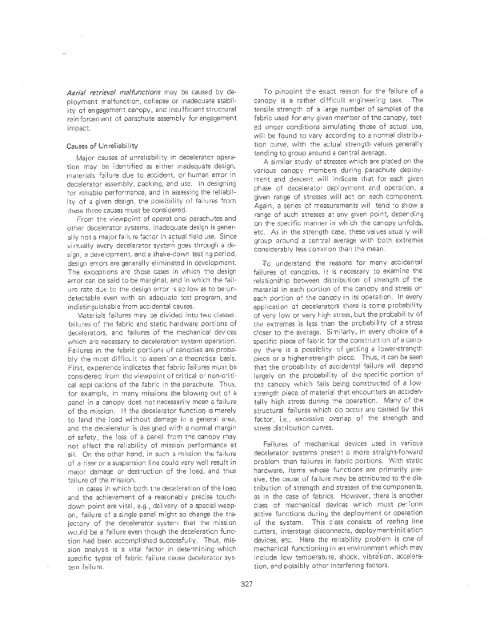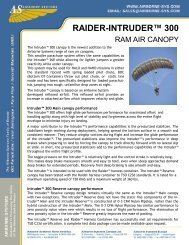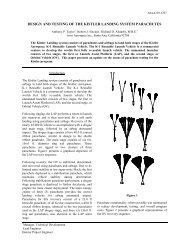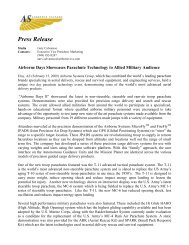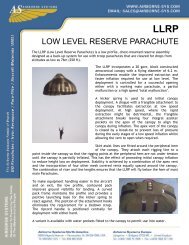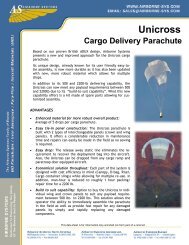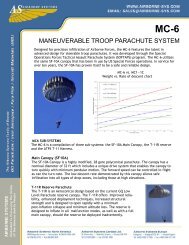"lfk f; \"A Lt. - Airborne Systems
"lfk f; \"A Lt. - Airborne Systems
"lfk f; \"A Lt. - Airborne Systems
You also want an ePaper? Increase the reach of your titles
YUMPU automatically turns print PDFs into web optimized ePapers that Google loves.
Aeria! retrieval malfunctions may be caused by deployment<br />
malfunctiQn , collapse or inadequate stability<br />
of engagement car'Opy. and insufficient structural<br />
rein forcernent of para-:hute assembly for engagement<br />
impact.<br />
Causes of Un reliabi I ity<br />
l'Aajor causes of unreliebillty In deceleratcr operation<br />
may be identified as either inadequate design.<br />
materials failure due to accident, or hurran error in<br />
decelerator assembly. j:8cking, and use, In designing<br />
for reliable performance. and in assessing the reliability<br />
of a given design. the possibility of failures from<br />
,hese three causes must be considered.<br />
From trle viewpoint of operat onal parach.;t8s and<br />
other decelerator systems, inadequate desi!;n is generally<br />
not a majorfai II. ra factor in actual field use. Since<br />
virtually every decelerator systerrl goes thruugh a de.<br />
sign, a development, and a shake-down te51'ng period,<br />
design errors are ger,erallv eliminated in development.<br />
The exceptions a"e those cases in whic!' the design<br />
error can be said to be marginal , and in which the failure<br />
rate d.J€ to the design error's so law as to be undetectable<br />
even with an adequate test program, and<br />
Indistinguishable from accidental causes.<br />
Mater ials failures may<br />
e divided intD two classes<br />
failures of t'le fabric and static hardware portions of<br />
decelerator., a'ld failures of the mechanical devices<br />
wh ich ace necessary to deceleration system operation,<br />
Failures in the fabric ponions of canooies are proba<br />
bly the most difficLlt o assess on a theoretica basis,<br />
First. experience indicates that fabric failures must be<br />
considered "from the viewpoint of critical oc non.c itieal<br />
applc8cions of the fabric in the parachute. Thus,<br />
for example, in many missions the blowing out of a<br />
panel in a canopy does not necessarily mean a failure<br />
of the mission. If the decelerator functior) is merely<br />
to land the IQad without damage in a general area,<br />
and the decelerator is des gned with a normal margin<br />
of safety the loss of a panel from t18 canopy may<br />
not affect the reliability of mission performance at<br />
all. On the other hand, in such a mission the failure<br />
of a riser or a suspension line could very well result in<br />
major damage or destruction of the load, and thus<br />
failLre of ,he rrission.<br />
In cases ih which both t'18 deceleration of the loao<br />
and the achie'./ement of a reasonably precise touchdown<br />
point are vital , e. g. delivery of OJ special weap-<br />
. failure of a single panel mighT so change the tra-<br />
jectory of the decelerator syster' l that the mission<br />
ld be a failure even though the deceleration func-<br />
tion had been accomplished successfully. Thus, mission<br />
analysis is a vital factor in dete"rnining which<br />
specific types of fabric failure cause decelerator sys.<br />
tem failure,<br />
327<br />
To pinpoint tre exact reason for tre failure of a<br />
canopy is a rather difficult er,gineering task, Thp.<br />
tensile strength of a ;arge number of samples of the<br />
fabric used for any given member of the canopy, test.<br />
ed lInoer conditions simulating those of actual use,<br />
will be found to vary according to a normal distri bu.<br />
tion curve, with the actual strength values generally<br />
tending to group around a central average,<br />
A similar study of stresses which are placed on the<br />
various canopy Members during parachute deploy.<br />
ment and descent will indicate that for each given<br />
phase of decelerator deployment and operation. a<br />
given range of stresses will act on each component.<br />
Again , a series of measurements wil tend o show a<br />
range of such stresses a1 any given point, deperding<br />
on the specific manner in which The canopy unfolds,<br />
etc, As in the s1rength case, these values usually will<br />
group around a cen:ral average with I:oth extremes<br />
considerably less common than the mean,<br />
:rc understand the reasons for many accidental<br />
failures of canopies, it is recessary to examine the<br />
relationship between distribution of strength of ti,e<br />
material in each portion of the canopy and stress or<br />
each portion oi the canQ\Y in its operation. In every<br />
application af decelerators there is some probability<br />
of very low or very high stress , but the probability of<br />
the extremes is less tnan the probabi lity of a stress<br />
closer to the average. Similarly. in every choice of a<br />
specific piece of fabric for the constructioll of a cano.<br />
py the'e is a possiblity of getting a lawer.strength<br />
piece or a higher.strength piece. Thus. it can be seen<br />
that the probDbility of accidental failure wil depe'ld<br />
largely on the probability of the specific portion of<br />
th2 canopy which fails being constructed of a low.<br />
strength piece of material trat encounter. an acciden-<br />
he operation. Many of trl8<br />
tally high stress during<br />
structural fail ures wh ich do DeCli r are caused by this<br />
factor , i.e" excessive ovsrlap of the strength and<br />
stress distribution curves.<br />
Failures of mechanical devices used in varicus<br />
decelerator systems present 8 more straight-forward<br />
probleM than failures in fabric portions. With static<br />
hardware, items whose functions are primarily p3Ssive,<br />
the cause of failure may be attributed to tre distribution<br />
of strength and stresses of the components<br />
as in the case of fabrics. However, "'here is another<br />
class of mec;"snical devices wrich mllst pe-form<br />
active functions during the deployment or operation<br />
of the system. This c, sss consists of reefing line<br />
cutters, interstage disconnects, deployment. init' aticn<br />
devices, etc. Here the relial)ilitv problem is one of<br />
mechanical functioning in an environment which may<br />
include low temperature, shock, vibration , accelera.<br />
tion, end possibly other interfering factors.


